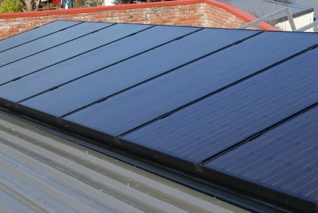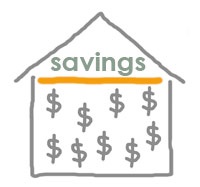making solar easy
solar electric
These are illustrative figures to give a ball park estimate of costs and benefits. It’s important to have your particular property assessed for its suitability and to get an accurate estimate of costs and benefits.
Costs may vary according to the type of roof and its accessibility.
Benefits may vary according to the amount of usable, generally north facing, unshaded roof area, as well as the electricity retailer you decide to use.
We will happily provide this assessment at no cost. Just contact us at click here
We’ve only used three system sizes for illustrative purposes, there are many more options available, up to and beyond 10kWp.
System price
Req’d roof area
sq. metres
Annual generation
kWh
Annual savings
At today’s’ prices
Annual return
% on investment
1.4 kWp
$6,395
9
2115
$626
9.8 %
3.0 kWp
$11,195
19
4230
$1,252
11.1%
5.0 kWp
$16,895
32
7050
$2,087
12.4%

Last but not least
As electricity prices increase, as they surely will, the capital value of energy efficient buildings will increase.
Overseas studies show that the increase in value can be roughly 15 times the annual electricity saving. For example if you are able to save $500 on your electricity bill you could add $7500 to the value of your home.
This trend is not yet fully evident in New Zealand but it’s reasonable to expect rising electricity prices will see New Zealand home values follow suit.
Certainly installing a solar electricity system will protect the investment in your home.
Of course annual savings and the annual return will increase as the price of electricity increases above today’s level. The chart shows the increase in average residential retail prices over the past 10 years (about 8% p.a.) - we leave you to draw your own conclusions as to future increases.
2 The inverter…
is at the heart of the system converting the solar electricity into electricity ready to use in your home. It is also the interface between your home and the electricity grid, controlling the flow of electricity between your home and the grid. Today’s smart inverters save and display this information so you can monitor the performance of your system.
Our first choice inverter for smaller systems is manufactured to the highest of standards by Enasolar in Christchurch New Zealand. They are supplied complete with a built–in Wi Fi and statistics package which enables real time monitoring of your systems performance by you, us and Enasolar. You can track your savings and we will be alerted should any problems develop.
For larger systems world-leading SMA inverters are normally specified. They have built in Bluetooth capability and a statistics package.
3 The meters …
measure the energy you receive from the grid and the energy you supply. You pay for what you receive and are credited for what you supply. The detail of this arrangement, including the electricity rates and meters, depend on the Retailer.
4 The grid connection
It’s useful to think of the national grid as a big battery. During the day, when your system is working to capacity, any surplus electricity not consumed in your home is exported to the grid.
At night, when your system is not working, your electricity needs are supplied by the grid.
How much electricity you choose to generate will depend on your electricity usage and your budget.
The output of all our modules is warranted for 25 years and you can expect them to still be operating in 40 years time.
Our ‘Architectural Line’ modules are supplied by Gaia Solar of Denmark. These low profile, all black modules incorporate the best of Danish design and will blend into most roofs.


Our ‘Best Buy’ systems are supplied by Powersmart Solar. Their modules are sourced from reputable suppliers with industry leading warranties and performance characteristics.

1 Solar modules ..
capture the energy of the sun and convert it into clean electricity, without noise and without CO2 emissions. Good quality modules combined with well designed and installed systems will blend in with the appearance of your house as well as attesting to your care for our environment.
How it all works




What happens if a solar electric system is installed on the roof?
It depends on the size of the system:
- has a floor are area of about 150 -200 m2
- is home to 2 adults and 1 child
- uses 8000 kWh of electricity pa
-
-pays 29.6 cents per kWh for electricity At todays prices
-
-has an annual electricity bill of $2100 At todays prices
© SOLARZONE New Zealand Ltd 2012

5a Arko Place
Paraparaumu, Kapiti Coast
Wellington, New Zealand
+64 (4) 297 3062


Grid Connect solar electricity systems
Solar electric systems come in two forms – stand alone and grid connect.
Stand alone systems work best where connecting to the grid would be very expensive or a grid connection is simply out of the question. They are relatively complex to design properly.
They incur additional costs to cover batteries plus, usually, a back up generator. They also require regular monitoring and maintenance.
Grid connect systems are integrated into the electricity grid. Electricity is available at all times. No batteries or generators are required and maintenance is minimal.
Over the past few years global demand for grid connect systems has grown rapidly. As production has been ramped up to meet this demand, prices have dropped significantly.
It has become common practice for electricity retailers to buy the surplus electricity that a grid connect system generates beyond that used in the home.
These changes mean that a generation technology once financially viable only in remote areas is now a sound investment for mainstream home owners and businesses. Not to mention the environmentally friendly CO2 saving from a fully renewable source.
The value proposition
Costs
Prices for our Best Value line range from $6,400 for the smallest system up to $16,900 for a system suitable for most large homes.
Prices include GST.
These prices include standard installation costs within the Wellington region (but do not include meter change fees).
The systems require only minimal maintenance.
The larger the system the more energy you will generate.
The best size system for you depends on:
•The amount of usable space on your roof
•Your budget
•Your total energy consumption
Benefits
Meridian energy will currently buy surplus energy from you at the same price they charge for what you use.
Your financial savings are directly proportional to the amount of energy your system generates, i.e. If you generate 50% of your total usage you save 50% of your power bill.
As the price of electricity increases, the dollar value of these savings will of course increase.
Putting it all together
For a ball park estimate of the cost/benefit equation, assume an average New Zealand home in the Wellington region:
